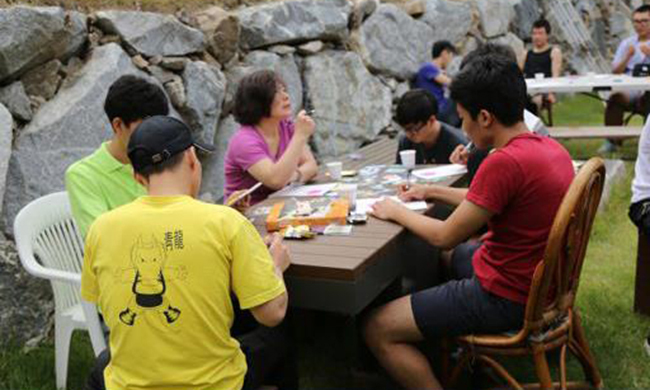Providing support for North Korean refugee youth
Hyong Yeom works with the Yeomyung School to address students' needs
NewsSUMMARY: In the summer of 2014, social work professor Hyong Yeom traveled to Seoul, South Korea to conduct research at an alternative school for North Korean refugee youths, Yeomyung School.
By: Laura Mack '16
Creative Services Student Writer

In the summer of 2014, social work professor Hyong Yeom travelled to Seoul, South Korea to conduct research at an alternative school for North Korean refugee youths, Yeomyung School. While this project originally began in 2013 with a primary focus on the development of the school’s curriculum, education professor Shin Ji Kang recruited Yeom to provide a different perspective upon realizing the complexity of the refugees’ situation. “The North Korean refugee youths have been struggling to adjust to the radically different demands of South Korean life and education, while still trying to overcome the traumas of their escape from North Korea,” said Yeom. “I found that they have a great array of support needs at the school, but that there are not many supportive programs available there.”
For the past three summers, Yeom has conducted needs assessments of the students to design programs that assist with their integration into South Korean culture and its educational system. To capture a holistic understanding of the school, Yeom interviewed students, teachers, administrative staff and dorm staff. “While I was performing the needs assessment, I was deeply involved and engaged with the students and the school,” explained Yeom. In addition to daily assistance in the classroom, Yeom also conducted workshops for teachers and administrators on refugee youth support programs in other countries.
Born and raised in South Korea, Yeom is no stranger to the cultural divide between North and South Korea. Since the 1990’s, the number of North Koreans attempting escape to South Korea has dramatically increased, due to famine and an economic recession under an oppressive regime. If caught, escapees face heavy punishments, which vary depending upon their economic or political reasons for leaving. In order to avoid capture, many North Koreans flee to China first, since it shares a longer, less regulated border with North Korea, as they make their way to South Korea. This journey between countries can be traumatic for both children and parents. While some parents bring their children with them, others must travel separately and work to raise enough money to provide for their children once they are able to escape. Because there is absolutely no communication between North and South Korea, this process can turn into years without any contact before their children arrive in South Korea.
To her surprise, Yeom found that the bulk of the trauma that students experience does not happen on their journey to South Korea. “My participants said that most trauma actually happens after they come to South Korea. It’s the adjustment to the new society,” Yeom said. “When they get to South Korea, family conflict arises. Sometimes the mothers remarry in South Korea, and conflicts break out between the children and the new stepfamily. Other times, the mother has arrived in South Korea long before the children. The mother works long and hard to save up enough money to bring the children over, but when they finally do arrive, the time apart has been so long that their relationship is severely strained.”
Tackling a language barrier, stark cultural divide and family conflict all at once is no easy feat for the students at Yeomyung School. In her study, Yeom proposed comprehensive supportive programs that included a variety of actions: employing a full-time school counselor to ease the burden on teachers who already perform multiple roles, providing greater assistance in difficult subject areas, increasing parental involvement in students’ education, reducing discrimination against North Koreans in the South Korean community and developing a coalition of alternative schools to secure government funding and legislation to support North Korean refugee youth.
Yeom presented data from her first summer at the International Conference on Diversity in Organizations, Communities and Nations in July, 2015, and it was later published as a paper for the International Journal of Diversity in Education in March 2016.

This past summer, Yeomyung School asked her to conduct further research on an emerging subpopulation of refugee youths: North Korean children who are born and raised in China before coming to South Korea. These children are often the product of sexual trafficking and forced marriages, which North Korean refugee women fall victim to while in China. “[The children] only know China. They speak Chinese. Approximately 100,000 to 130,000 North Koreans are hiding and surviving in China, and those North Korean mothers are trying to come to South Korea.” said Yeom. The number of these students has increased so much that they now make up one-third of the Yeomyung School. Yeom described the emotional in-depth interviews she conducted with both students and their mothers: “I had a deep relationship with them. I would visit them and sometimes end up sleeping over at their houses, because just one interview would last three hours…and then keep going on. Their life experiences are so enormous; you cannot finish in just one hour. Some participants say, ‘Teacher let’s go to my home and I’ll keep telling you my story.’”
As Yeom continues to work with the Yeomyung School, she sees her study as a model for more wide-ranging approaches to refugee assistance programs. “We need to understand their specific needs for various levels of support: at home, in school, in the community and from the government and society in general,” said Yeom. Comprehensive, individualized programs could be the key to successfully integrating refugee youth into their schools and communities.

